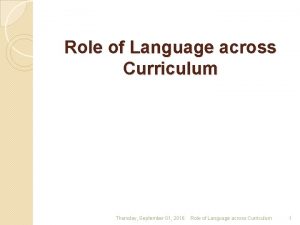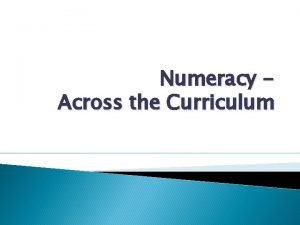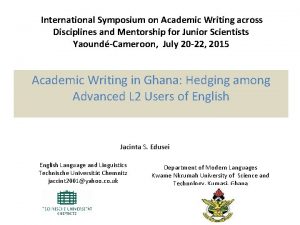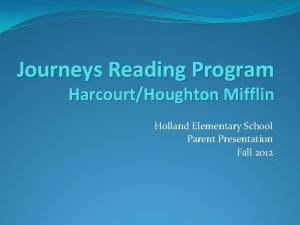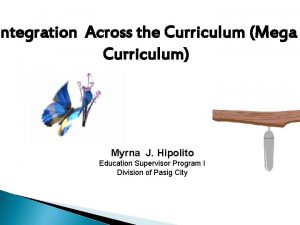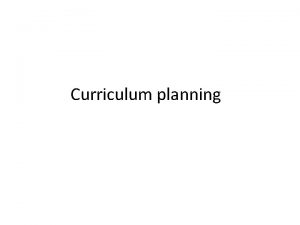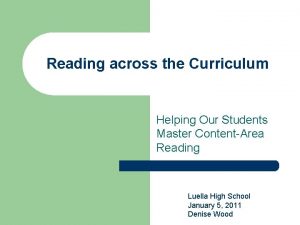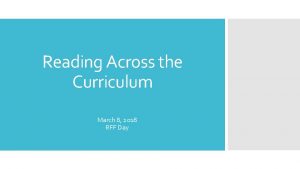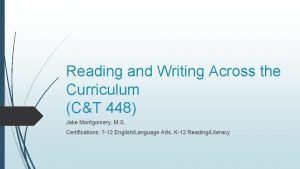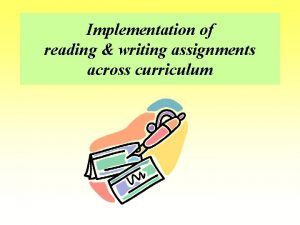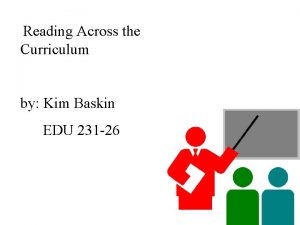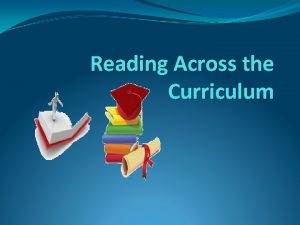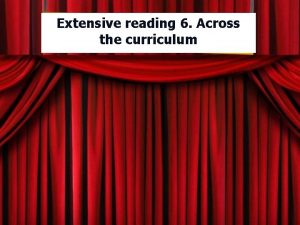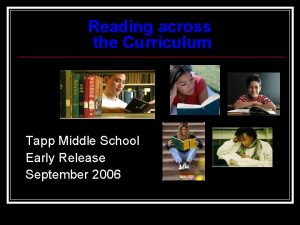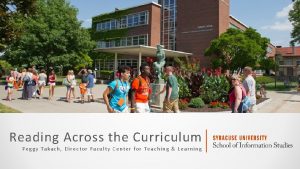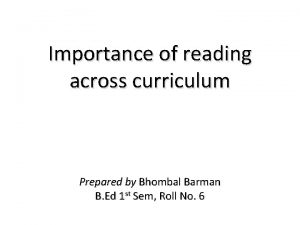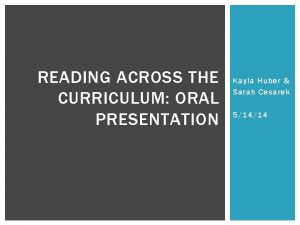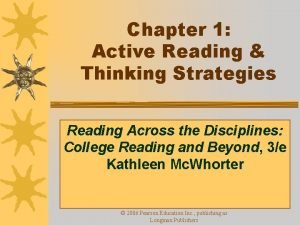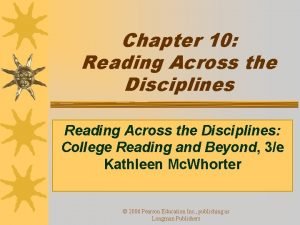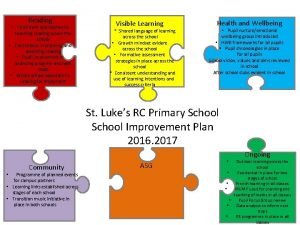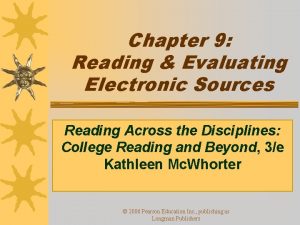Planning of Reading across the Curriculum 1 Planning





























- Slides: 29

Planning of Reading across the Curriculum 1

Planning of Reading across the Curriculum Outline 1. Background 2. Making connection between learning in the English and the GS subjects Shatin Tsung Tsin School 3. Making connection between learning in the classroom and in real life situations Mary of Providence Primary School 4. Reflection 2

Challenges faced by our students • Coping with the exponential growth of information and knowledge • Globalisation and competition • Meeting the learning demands at the secondary level 3

The key – Reading, reading Reading skills & strategies Reading atmosphere and culture Making connections Reading habit Reading interest 4

The key – Reading, reading Reading skills & strategies Reading atmosphere and culture Reading across the curriculum Reading habit Reading interest 5

Why Reading across the Curriculum • To help students make connections between the reading texts across various KLAs and their life experiences, prior knowledge and global affairs. • To enable students to gain knowledge of different areas and apply reading skills and strategies to retrieve different types of content knowledge • To help students extend their horizons, construct knowledge, enhance their creativity and develop positive values. Source: Basic Education Curriculum Guide for Primary 1 – 6 (2014) 6

School practices in promoting Reading across the Curriculum Shatin Tsung Tsin School Mary of Providence Primary School • Average to high performance in English • Most students do not reject reading, yet there is diversity in their interest in and habit for reading Current practices • Explicit teaching of reading skills and strategies • Adoption of reading schemes in promoting • Positive experience in teacher collaboration in promoting reading Student characteristics Students’ development needs • Prepare senior primary students for learning at the secondary level • Developing lifelong learning capabilities among students Subject development focus Promotion of reading across the curriculum – making links between the formal and the informal curricula 7

Planning of the reading curriculum to achieve learning to learn Formal curriculum Ø Key features of each module Informal curriculum Set common themes for crosssubject collaboration Set target reading skills and learning to learn skills Increase the quantity and types of reading/viewing materials Provide opportunities for sharing of reading/learning experiences Adopt tools to help students process & organise learning English Library General Studies Ø Reading schemes • Buddy reading programme • Extensive reading scheme • Library periods Ø Life-wide learning projects • Study tour 8

Case 1 Shatin Tsung Tsin School Making connection between learning in the English and the GS subjects 9

Planning of the ‘Save our Earth’ module Sub-themes: Environmental Protection + Endangered Animals Target group: a class of 30 P. 6 students Period: 4 weeks English curriculum • Read extensively on Library environmental protection • Resource • Teach reading skills and management strategies explicitly • Library • Teach the use of graphic periods organizers to find out main ideas GS curriculum • Deepen the knowledge about environmental protection • Apply reading skills and strategies in reading non-fiction books and newspaper 10

of project the Ra. C project Design of. Design the Ra. C Knowledge Building English Content Language • Causes and solutions of environmental problems G. S. • Effects of environmental problems Lexical sets Examples: air pollution, fumes, smoke, power stations, factories, use public transport, plant more trees Lexical sets Examples: global warming, greenhouse effect, ozone hole, acid rain (effects of air pollution) Grammar structures • Use so much and so many to talk about the quantities of things (e. g. Useful verbs • Air pollution causes acid rain. • Water pollution causes red tides. • Water pollution affects the ecosystem and human health. • • The traffic makes so much noise. ) Use should / should not to talk about ways of protecting the environment (e. g. We should stop leaving the tap on. ) Use connectives to add ideas and to show the cause-effect relationship (e. g. also, as a result) 11

of project the Ra. C project Design of. Design the Ra. C English Reading skills G. S. Skills of reading non-fiction texts • Locate specific information Look at contents page, headings, illustrations and captions • Skim for main ideas Find out the topic sentences Use graphic organizers to organize the causes, effects and solutions Application of reading skills • Understand information presented in charts and graphs • Read non-fiction texts of different topics (e. g. light pollution, noise pollution, environmental problems) • Extensive reading scheme to encourage students to read nonfiction books 12

Design of the Ra. C project Save our Earth English Learning outcomes • Write an article about the causes, effects and solutions of environmental problems • Present a group project to show the causes, effects and solutions of an environmental problem General Studies • • K-W-L chart Hold group discussion to reflect on what have been learnt 13

Examples of Learning Resources Organise the ideas of causes, effects and solutions of environmental problems English G. S. English 14

Examples of Learning Resources Distinguish between causes and effects English 15

Examples of Learning Resources Use so much and so many to talk about the quantities of things 16

Examples of Learning Resources Extensive reading scheme to encourage students to read non-fiction books Super Readers’ Scheme Students borrow nonfiction books of environmental protection from the library and complete the graphic organizers. 17

Learning outcomes - English Write an article about environmental problems (causes, effects and solutions) 18

Learning outcomes - English • Students are able to show the audience the causes, effects and solutions of an environmental problem in their project presentation. • Students are able to synthesize what they have learnt from English and G. S. lessons and the books they have read. 19

Learning outcomes of - General Studies Use the K-W-L chart to organise the previous knowledge, decide what to find out and summarise the ideas learnt 20

Role of the Library ü Enrich the resources (non-fiction books of English and G. S. ) in the library. ü Recommend and display the non-fiction books. ü Display related newspaper clippings. ü Read non-fiction books of environmental protection in library lessons. 21

How would students benefit from this Ra. C project? ØEnhance students’ understanding of a topic (environmental protection) ØEquip students with a wider range of skills and strategies of reading nonfiction texts ØIncrease students’ reading amount and variety of nonfiction books 22

Case 2 Mary of Providence Primary School Making connection between learning in the classroom and in real life situations 23

Design of a two-year reading project Formal curriculum (Inside the classroom) Informal curriculum (Outside the classroom) Year: 2014/15 Target group: All P. 5 students Unit: Fun with study tours Curriculum planning features: Greater variety and quantity of reading materials Coverage of reading skills & learning to learn skills Authentic and challenging tasks to prepare students for real life needs English + Library Year: 2015/16 Target group: 24 P. 6 students Life-wide learning project: A 4 -day study tour to Singapore Curriculum planning features: P Extensive reading on the places to visit in Singapore P Further practice of learning to learning skills P Engaging students in planning, documenting and managing their learning 24

What happened in the classroom? P. 5 Unit 4: Fun with study tours Learning tasks Objectives/Features 1. Read a blog to find out the travelling experience of Ken • Read for specific information • Learn the features of a blog 2. Practise booking of flight online • Expose students to real life tasks • Practise IT skills • Follow instructions 3. Read hotel reviews and choose a hotel • Develop critical thinking • Learn the features of a review 4. Conduct research on different scenic spots and recommend a place to visit • Read extensively on different places • Take notes • Synthesise information 5. Write a travel blog on a place visited • Integrate reading with writing • Elaborate and organise ideas 6. Review peer’s travel blog against a set of criteria • Promote self-reflection and peer learning 25

What happened outside the classroom? A study tour to Singapore 1. Pre-trip training (Oct 2015 – Mar 2016) Tasks Objectives/features Prepare an introduction of a place to visit in Singapore • Develop reading & research skills • Develop summarising skills • Set learning outcomes Present the place to the whole group • Practise presentation skills (confidence, eye-contact, interaction) • Give and respond to feedback Make learning pledges and a reminder list on what to prepare/do before, during and after the trip • Develop self-management skills (e. g. goal setting) • Develop higher order thinking skill (categorise items on the reminder list) 26

What happened outside the classroom? A study tour to Singapore 1. Pre-trip training (Oct 2015 – Mar 2016) Tasks Objectives/features Prepare questions for the visit and the interview • Develop self-directed learning skills (set learning expectations) Video-tape their own presentation (introducing a place at the school) • Learn advanced IT skills (photo and videotaking) • Integrate the use of multiple skills (IT, writing, presentation) • Prepare for the post-trip sharing Share the videos produced by each group and give feedback • Promote peer assessment and reflection 27

What happened outside the classroom? A study tour to Singapore 2. During and Post-trip activities (May - July 2016) Tasks Objectives/features Engage in different learning tasks actively • Practise communication skills • Foster collaboration • Enhance proper attitude and behaviour Capture and reflect on their learning every day • Consolidate learning skills (note-taking, summarising, organising learning) • Apply advanced IT skills (taking photos and videos) • Encourage on-going reflection Conduct post-trip sharing • Consolidate presentation skills • Build a language rich environment at school 28

Reflection Build on teachers’ strengths Expertise Interest Dedication Collaboration Build on students’ strengths • Positive learning attitudes • Good language foundation Holistic planning Build on existing programmes Reading schemes Library periods Flexible curriculum arrangements Teachers’ professional discretion on the use of textbook to create space for learning 29
 While reading activities
While reading activities Language across the curriculum conclusion
Language across the curriculum conclusion Numeracy across the curriculum audit
Numeracy across the curriculum audit Academic english reading and writing across the disciplines
Academic english reading and writing across the disciplines Journeys literacy program
Journeys literacy program Hình ảnh bộ gõ cơ thể búng tay
Hình ảnh bộ gõ cơ thể búng tay Lp html
Lp html Bổ thể
Bổ thể Tỉ lệ cơ thể trẻ em
Tỉ lệ cơ thể trẻ em Chó sói
Chó sói Tư thế worm breton
Tư thế worm breton Bài hát chúa yêu trần thế alleluia
Bài hát chúa yêu trần thế alleluia Kể tên các môn thể thao
Kể tên các môn thể thao Thế nào là hệ số cao nhất
Thế nào là hệ số cao nhất Các châu lục và đại dương trên thế giới
Các châu lục và đại dương trên thế giới Công thức tính thế năng
Công thức tính thế năng Trời xanh đây là của chúng ta thể thơ
Trời xanh đây là của chúng ta thể thơ Mật thư anh em như thể tay chân
Mật thư anh em như thể tay chân Làm thế nào để 102-1=99
Làm thế nào để 102-1=99 Phản ứng thế ankan
Phản ứng thế ankan Các châu lục và đại dương trên thế giới
Các châu lục và đại dương trên thế giới Thể thơ truyền thống
Thể thơ truyền thống Quá trình desamine hóa có thể tạo ra
Quá trình desamine hóa có thể tạo ra Một số thể thơ truyền thống
Một số thể thơ truyền thống Cái miệng nó xinh thế
Cái miệng nó xinh thế Vẽ hình chiếu vuông góc của vật thể sau
Vẽ hình chiếu vuông góc của vật thể sau Nguyên nhân của sự mỏi cơ sinh 8
Nguyên nhân của sự mỏi cơ sinh 8 đặc điểm cơ thể của người tối cổ
đặc điểm cơ thể của người tối cổ Ví dụ về giọng cùng tên
Ví dụ về giọng cùng tên Vẽ hình chiếu đứng bằng cạnh của vật thể
Vẽ hình chiếu đứng bằng cạnh của vật thể

